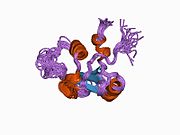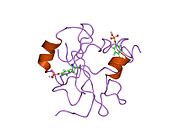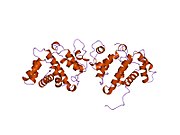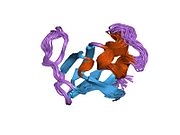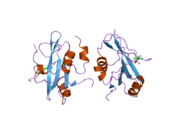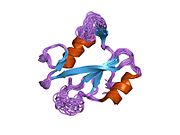PIK3R1
Template:PBB Phosphatidylinositol 3-kinase regulatory subunit alpha is an enzyme that in humans is encoded by the PIK3R1 gene.[1]
Function
Phosphatidylinositol 3-kinase phosphorylates the inositol ring of phosphatidylinositol at the 3-prime position. The enzyme comprises a 110 kD catalytic subunit and a regulatory subunit of either 85, 55, or 50 kD. This gene encodes the 85 kD regulatory subunit. Phosphatidylinositol 3-kinase plays an important role in the metabolic actions of insulin, and a mutation in this gene has been associated with insulin resistance. Alternative splicing of this gene results in three transcript variants encoding different isoforms.[2]
Clinical significance
Mutations in PIK3R1 are implicated in cases of Template:SWL.[3]
Mutations in PIK3R1 are associated to Template:SWL.[4]
Interactions
PIK3R1 has been shown to interact with:
- ADAM12,[5]
- BCAR1,[6]
- CBLB,[7][8]
- CD117,[9][10][11]
- CD28,[12]
- CD7,[13][14]
- CENTG1,[15]
- CBL,[16][17][18]
- EPHA2,[19]
- EPOR,[20][21]
- ERBB3,[22][23]
- EZR,[24]
- FCGR2A,[25][26]
- GAB1,[27][28][29]
- GAB2,[30][31]
- Grb2,[32][33]
- HRAS,[34][35]
- IRS1[36][37][38][39]
- IRS2,[36][40][41][42]
- IL1R1,[43]
- JAK2,[44]
- KHDRBS1,[45][46]
- LTK,[47][48]
- LAT,[49]
- LCP2,[50]
- PIK3CD,[51]
- PTK2,[52]
- SHB,[53]
- TUBA1B,[54]
- TYRO3,[55]
- VAV1,[20][27] and
- WAS.[56]
References
- ^ Volinia S, Patracchini P, Otsu M, Hiles I, Gout I, Calzolari E, Bernardi F, Rooke L, Waterfield MD (May 1992). "Chromosomal localization of human p85 alpha, a subunit of phosphatidylinositol 3-kinase, and its homologue p85 beta". Oncogene. 7 (4): 789–93. PMID 1314371.
- ^ "Entrez Gene: PIK3R1 phosphoinositide-3-kinase, regulatory subunit 1 (p85 alpha)".
- ^ The Cancer Genome AN (October 2012). "Comprehensive molecular portraits of human breast tumours". Nature. 490 (7418): 61–70. doi:10.1038/nature11412. PMC 3465532. PMID 23000897.
{{cite journal}}: Vancouver style error: initials in name 1 (help) - ^ Bárcena C, Quesada V, De Sandre-Giovannoli A, Puente DA, Fernández-Toral J, Sigaudy S, Baban A, Lévy N, Velasco G, López-Otín C (2014). "Exome sequencing identifies a novel mutation in PIK3R1 as the cause of SHORT syndrome". BMC Med. Genet. 15 (1): 51. doi:10.1186/1471-2350-15-51. PMC 4022398. PMID 24886349.
{{cite journal}}: CS1 maint: unflagged free DOI (link) - ^ Kang Q, Cao Y, Zolkiewska A (2001). "Direct interaction between the cytoplasmic tail of ADAM 12 and the Src homology 3 domain of p85alpha activates phosphatidylinositol 3-kinase in C2C12 cells". J. Biol. Chem. 276 (27): 24466–72. doi:10.1074/jbc.M101162200. PMID 11313349.
{{cite journal}}: CS1 maint: unflagged free DOI (link) - ^ Li E, Stupack DG, Brown SL, Klemke R, Schlaepfer DD, Nemerow GR (2000). "Association of p130CAS with phosphatidylinositol-3-OH kinase mediates adenovirus cell entry". J. Biol. Chem. 275 (19): 14729–35. doi:10.1074/jbc.275.19.14729. PMID 10799562.
{{cite journal}}: CS1 maint: unflagged free DOI (link) - ^ Lavagna-Sévenier C, Marchetto S, Birnbaum D, Rosnet O (1998). "The CBL-related protein CBLB participates in FLT3 and interleukin-7 receptor signal transduction in pro-B cells". J. Biol. Chem. 273 (24): 14962–7. doi:10.1074/jbc.273.24.14962. PMID 9614102.
{{cite journal}}: CS1 maint: unflagged free DOI (link) - ^ Elly C, Witte S, Zhang Z, Rosnet O, Lipkowitz S, Altman A, Liu YC (1999). "Tyrosine phosphorylation and complex formation of Cbl-b upon T cell receptor stimulation". Oncogene. 18 (5): 1147–56. doi:10.1038/sj.onc.1202411. PMID 10022120.
- ^ De Sepulveda P, Okkenhaug K, Rose JL, Hawley RG, Dubreuil P, Rottapel R (1999). "Socs1 binds to multiple signalling proteins and suppresses steel factor-dependent proliferation". EMBO J. 18 (4): 904–15. doi:10.1093/emboj/18.4.904. PMC 1171183. PMID 10022833.
- ^ van Dijk TB, van Den Akker E, Amelsvoort MP, Mano H, Löwenberg B, von Lindern M (2000). "Stem cell factor induces phosphatidylinositol 3'-kinase-dependent Lyn/Tec/Dok-1 complex formation in hematopoietic cells". Blood. 96 (10): 3406–13. PMID 11071635.
- ^ Serve H, Hsu YC, Besmer P (1994). "Tyrosine residue 719 of the c-kit receptor is essential for binding of the P85 subunit of phosphatidylinositol (PI) 3-kinase and for c-kit-associated PI 3-kinase activity in COS-1 cells". J. Biol. Chem. 269 (8): 6026–30. PMID 7509796.
- ^ Pagès F, Ragueneau M, Klasen S, Battifora M, Couez D, Sweet R, Truneh A, Ward SG, Olive D (1996). "Two distinct intracytoplasmic regions of the T-cell adhesion molecule CD28 participate in phosphatidylinositol 3-kinase association". J. Biol. Chem. 271 (16): 9403–9. doi:10.1074/jbc.271.16.9403. PMID 8621607.
{{cite journal}}: CS1 maint: unflagged free DOI (link) - ^ Lee DM, Patel DD, Pendergast AM, Haynes BF (1996). "Functional association of CD7 with phosphatidylinositol 3-kinase: interaction via a YEDM motif". Int. Immunol. 8 (8): 1195–203. doi:10.1093/intimm/8.8.1195. PMID 8918688.
- ^ Subrahmanyam G, Rudd CE, Schneider H (2003). "Association of T cell antigen CD7 with type II phosphatidylinositol-4 kinase, a key component in pathways of inositol phosphate turnover". Eur. J. Immunol. 33 (1): 46–52. doi:10.1002/immu.200390006. PMID 12594831.
- ^ Ye K, Hurt KJ, Wu FY, Fang M, Luo HR, Hong JJ, Blackshaw S, Ferris CD, Snyder SH (2000). "Pike. A nuclear gtpase that enhances PI3kinase activity and is regulated by protein 4.1N". Cell. 103 (6): 919–30. doi:10.1016/S0092-8674(00)00195-1. PMID 11136977.
- ^ Gesbert F, Garbay C, Bertoglio J (1998). "Interleukin-2 stimulation induces tyrosine phosphorylation of p120-Cbl and CrkL and formation of multimolecular signaling complexes in T lymphocytes and natural killer cells". J. Biol. Chem. 273 (7): 3986–93. doi:10.1074/jbc.273.7.3986. PMID 9461587.
{{cite journal}}: CS1 maint: unflagged free DOI (link) - ^ Zhang S, Broxmeyer HE (1999). "p85 subunit of PI3 kinase does not bind to human Flt3 receptor, but associates with SHP2, SHIP, and a tyrosine-phosphorylated 100-kDa protein in Flt3 ligand-stimulated hematopoietic cells". Biochem. Biophys. Res. Commun. 254 (2): 440–5. doi:10.1006/bbrc.1998.9959. PMID 9918857.
- ^ Dufour C, Guenou H, Kaabeche K, Bouvard D, Sanjay A, Marie PJ (2008). "FGFR2-Cbl interaction in lipid rafts triggers attenuation of PI3K/Akt signaling and osteoblast survival". Bone. 42 (6): 1032–9. doi:10.1016/j.bone.2008.02.009. PMID 18374639.
- ^ Pandey A, Lazar DF, Saltiel AR, Dixit VM (1994). "Activation of the Eck receptor protein tyrosine kinase stimulates phosphatidylinositol 3-kinase activity". J. Biol. Chem. 269 (48): 30154–7. PMID 7982920.
- ^ a b Shigematsu H, Iwasaki H, Otsuka T, Ohno Y, Arima F, Niho Y (1997). "Role of the vav proto-oncogene product (Vav) in erythropoietin-mediated cell proliferation and phosphatidylinositol 3-kinase activity". J. Biol. Chem. 272 (22): 14334–40. doi:10.1074/jbc.272.22.14334. PMID 9162069.
{{cite journal}}: CS1 maint: unflagged free DOI (link) - ^ Damen JE, Cutler RL, Jiao H, Yi T, Krystal G (1995). "Phosphorylation of tyrosine 503 in the erythropoietin receptor (EpR) is essential for binding the P85 subunit of phosphatidylinositol (PI) 3-kinase and for EpR-associated PI 3-kinase activity". J. Biol. Chem. 270 (40): 23402–8. doi:10.1074/jbc.270.40.23402. PMID 7559499.
{{cite journal}}: CS1 maint: unflagged free DOI (link) - ^ Hellyer NJ, Kim MS, Koland JG (2001). "Heregulin-dependent activation of phosphoinositide 3-kinase and Akt via the ErbB2/ErbB3 co-receptor". J. Biol. Chem. 276 (45): 42153–61. doi:10.1074/jbc.M102079200. PMID 11546794.
{{cite journal}}: CS1 maint: unflagged free DOI (link) - ^ Lin J, Adam RM, Santiestevan E, Freeman MR (1999). "The phosphatidylinositol 3'-kinase pathway is a dominant growth factor-activated cell survival pathway in LNCaP human prostate carcinoma cells". Cancer Res. 59 (12): 2891–7. PMID 10383151.
- ^ Gautreau A, Poullet P, Louvard D, Arpin M (1999). "Ezrin, a plasma membrane-microfilament linker, signals cell survival through the phosphatidylinositol 3-kinase/Akt pathway". Proc. Natl. Acad. Sci. U.S.A. 96 (13): 7300–5. doi:10.1073/pnas.96.13.7300. PMC 22080. PMID 10377409.
- ^ Chacko GW, Brandt JT, Coggeshall KM, Anderson CL (1996). "Phosphoinositide 3-kinase and p72syk noncovalently associate with the low affinity Fc gamma receptor on human platelets through an immunoreceptor tyrosine-based activation motif. Reconstitution with synthetic phosphopeptides". J. Biol. Chem. 271 (18): 10775–81. doi:10.1074/jbc.271.18.10775. PMID 8631888.
{{cite journal}}: CS1 maint: unflagged free DOI (link) - ^ Ibarrola I, Vossebeld PJ, Homburg CH, Thelen M, Roos D, Verhoeven AJ (1997). "Influence of tyrosine phosphorylation on protein interaction with FcgammaRIIa". Biochim. Biophys. Acta. 1357 (3): 348–58. doi:10.1016/S0167-4889(97)00034-7. PMID 9268059.
- ^ a b Bertagnolo V, Marchisio M, Volinia S, Caramelli E, Capitani S (1998). "Nuclear association of tyrosine-phosphorylated Vav to phospholipase C-gamma1 and phosphoinositide 3-kinase during granulocytic differentiation of HL-60 cells". FEBS Lett. 441 (3): 480–4. doi:10.1016/S0014-5793(98)01593-2. PMID 9891995.
- ^ Holgado-Madruga M, Emlet DR, Moscatello DK, Godwin AK, Wong AJ (1996). "A Grb2-associated docking protein in EGF- and insulin-receptor signalling". Nature. 379 (6565): 560–4. doi:10.1038/379560a0. PMID 8596638.
- ^ Rocchi S, Tartare-Deckert S, Murdaca J, Holgado-Madruga M, Wong AJ, Van Obberghen E (1998). "Determination of Gab1 (Grb2-associated binder-1) interaction with insulin receptor-signaling molecules". Mol. Endocrinol. 12 (7): 914–23. doi:10.1210/mend.12.7.0141. PMID 9658397.
- ^ Lynch DK, Daly RJ (2002). "PKB-mediated negative feedback tightly regulates mitogenic signalling via Gab2". EMBO J. 21 (1–2): 72–82. doi:10.1093/emboj/21.1.72. PMC 125816. PMID 11782427.
- ^ Crouin C, Arnaud M, Gesbert F, Camonis J, Bertoglio J (2001). "A yeast two-hybrid study of human p97/Gab2 interactions with its SH2 domain-containing binding partners". FEBS Lett. 495 (3): 148–53. doi:10.1016/S0014-5793(01)02373-0. PMID 11334882.
- ^ Saleem A, Kharbanda S, Yuan ZM, Kufe D (1995). "Monocyte colony-stimulating factor stimulates binding of phosphatidylinositol 3-kinase to Grb2.Sos complexes in human monocytes". J. Biol. Chem. 270 (18): 10380–3. doi:10.1074/jbc.270.18.10380. PMID 7737969.
{{cite journal}}: CS1 maint: unflagged free DOI (link) - ^ Wang J, Auger KR, Jarvis L, Shi Y, Roberts TM (1995). "Direct association of Grb2 with the p85 subunit of phosphatidylinositol 3-kinase". J. Biol. Chem. 270 (21): 12774–80. doi:10.1074/jbc.270.21.12774. PMID 7759531.
{{cite journal}}: CS1 maint: unflagged free DOI (link) - ^ Hanna AN, Chan EY, Xu J, Stone JC, Brindley DN (1999). "A novel pathway for tumor necrosis factor-alpha and ceramide signaling involving sequential activation of tyrosine kinase, p21(ras), and phosphatidylinositol 3-kinase". J. Biol. Chem. 274 (18): 12722–9. doi:10.1074/jbc.274.18.12722. PMID 10212255.
{{cite journal}}: CS1 maint: unflagged free DOI (link) - ^ Rodriguez-Viciana P, Warne PH, Khwaja A, Marte BM, Pappin D, Das P, Waterfield MD, Ridley A, Downward J (1997). "Role of phosphoinositide 3-OH kinase in cell transformation and control of the actin cytoskeleton by Ras". Cell. 89 (3): 457–67. doi:10.1016/S0092-8674(00)80226-3. PMID 9150145.
- ^ a b Hamer I, Foti M, Emkey R, Cordier-Bussat M, Philippe J, De Meyts P, Maeder C, Kahn CR, Carpentier JL (2002). "An arginine to cysteine(252) mutation in insulin receptors from a patient with severe insulin resistance inhibits receptor internalisation but preserves signalling events". Diabetologia. 45 (5): 657–67. doi:10.1007/s00125-002-0798-5. PMID 12107746.
- ^ Hadari YR, Tzahar E, Nadiv O, Rothenberg P, Roberts CT, LeRoith D, Yarden Y, Zick Y (1992). "Insulin and insulinomimetic agents induce activation of phosphatidylinositol 3'-kinase upon its association with pp185 (IRS-1) in intact rat livers". J. Biol. Chem. 267 (25): 17483–6. PMID 1381348.
- ^ Morrison KB, Tognon CE, Garnett MJ, Deal C, Sorensen PH (2002). "ETV6-NTRK3 transformation requires insulin-like growth factor 1 receptor signaling and is associated with constitutive IRS-1 tyrosine phosphorylation". Oncogene. 21 (37): 5684–95. doi:10.1038/sj.onc.1205669. PMID 12173038.
- ^ Gual P, Gonzalez T, Grémeaux T, Barres R, Le Marchand-Brustel Y, Tanti JF (2003). "Hyperosmotic stress inhibits insulin receptor substrate-1 function by distinct mechanisms in 3T3-L1 adipocytes". J. Biol. Chem. 278 (29): 26550–7. doi:10.1074/jbc.M212273200. PMID 12730242.
{{cite journal}}: CS1 maint: unflagged free DOI (link) - ^ Argetsinger LS, Norstedt G, Billestrup N, White MF, Carter-Su C (1996). "Growth hormone, interferon-gamma, and leukemia inhibitory factor utilize insulin receptor substrate-2 in intracellular signaling". J. Biol. Chem. 271 (46): 29415–21. doi:10.1074/jbc.271.46.29415. PMID 8910607.
{{cite journal}}: CS1 maint: unflagged free DOI (link) - ^ Verdier F, Chrétien S, Billat C, Gisselbrecht S, Lacombe C, Mayeux P (1997). "Erythropoietin induces the tyrosine phosphorylation of insulin receptor substrate-2. An alternate pathway for erythropoietin-induced phosphatidylinositol 3-kinase activation". J. Biol. Chem. 272 (42): 26173–8. doi:10.1074/jbc.272.42.26173. PMID 9334184.
{{cite journal}}: CS1 maint: unflagged free DOI (link) - ^ Kim B, Cheng HL, Margolis B, Feldman EL (1998). "Insulin receptor substrate 2 and Shc play different roles in insulin-like growth factor I signaling". J. Biol. Chem. 273 (51): 34543–50. doi:10.1074/jbc.273.51.34543. PMID 9852124.
{{cite journal}}: CS1 maint: unflagged free DOI (link) - ^ Reddy SA, Huang JH, Liao WS (1997). "Phosphatidylinositol 3-kinase in interleukin 1 signaling. Physical interaction with the interleukin 1 receptor and requirement in NFkappaB and AP-1 activation". J. Biol. Chem. 272 (46): 29167–73. doi:10.1074/jbc.272.46.29167. PMID 9360994.
{{cite journal}}: CS1 maint: unflagged free DOI (link) - ^ Fuhrer DK, Yang YC (1996). "Complex formation of JAK2 with PP2A, P13K, and Yes in response to the hematopoietic cytokine interleukin-11". Biochem. Biophys. Res. Commun. 224 (2): 289–96. doi:10.1006/bbrc.1996.1023. PMID 8702385.
- ^ Sánchez-Margalet V, Najib S (2001). "Sam68 is a docking protein linking GAP and PI3K in insulin receptor signaling". Mol. Cell. Endocrinol. 183 (1–2): 113–21. doi:10.1016/S0303-7207(01)00587-1. PMID 11604231.
- ^ Shen Z, Batzer A, Koehler JA, Polakis P, Schlessinger J, Lydon NB, Moran MF (1999). "Evidence for SH3 domain directed binding and phosphorylation of Sam68 by Src". Oncogene. 18 (33): 4647–53. doi:10.1038/sj.onc.1203079. PMID 10467411.
- ^ Kozutsumi H, Toyoshima H, Hagiwara K, Yazaki Y, Hirai H (1994). "Human ltk receptor tyrosine kinase binds to PLC-gamma 1, PI3-K, GAP and Raf-1 in vivo". Oncogene. 9 (10): 2991–8. PMID 8084603.
- ^ Ueno H, Honda H, Nakamoto T, Yamagata T, Sasaki K, Miyagawa K, Mitani K, Yazaki Y, Hirai H (1997). "The phosphatidylinositol 3' kinase pathway is required for the survival signal of leukocyte tyrosine kinase". Oncogene. 14 (25): 3067–72. doi:10.1038/sj.onc.1201153. PMID 9223670.
- ^ Paz PE, Wang S, Clarke H, Lu X, Stokoe D, Abo A (2001). "Mapping the Zap-70 phosphorylation sites on LAT (linker for activation of T cells) required for recruitment and activation of signalling proteins in T cells". Biochem. J. 356 (Pt 2): 461–71. doi:10.1042/0264-6021:3560461. PMC 1221857. PMID 11368773.
- ^ Shim EK, Moon CS, Lee GY, Ha YJ, Chae SK, Lee JR (2004). "Association of the Src homology 2 domain-containing leukocyte phosphoprotein of 76 kD (SLP-76) with the p85 subunit of phosphoinositide 3-kinase". FEBS Lett. 575 (1–3): 35–40. doi:10.1016/j.febslet.2004.07.090. PMID 15388330.
- ^ Vanhaesebroeck B, Welham MJ, Kotani K, Stein R, Warne PH, Zvelebil MJ, Higashi K, Volinia S, Downward J, Waterfield MD (1997). "P110delta, a novel phosphoinositide 3-kinase in leukocytes". Proc. Natl. Acad. Sci. U.S.A. 94 (9): 4330–5. doi:10.1073/pnas.94.9.4330. PMC 20722. PMID 9113989.
- ^ Guinebault C, Payrastre B, Racaud-Sultan C, Mazarguil H, Breton M, Mauco G, Plantavid M, Chap H (1995). "Integrin-dependent translocation of phosphoinositide 3-kinase to the cytoskeleton of thrombin-activated platelets involves specific interactions of p85 alpha with actin filaments and focal adhesion kinase". J. Cell Biol. 129 (3): 831–42. doi:10.1083/jcb.129.3.831. PMC 2120444. PMID 7537275.
- ^ Karlsson T, Songyang Z, Landgren E, Lavergne C, Di Fiore PP, Anafi M, Pawson T, Cantley LC, Claesson-Welsh L, Welsh M (1995). "Molecular interactions of the Src homology 2 domain protein Shb with phosphotyrosine residues, tyrosine kinase receptors and Src homology 3 domain proteins". Oncogene. 10 (8): 1475–83. PMID 7537362.
- ^ Kapeller R, Toker A, Cantley LC, Carpenter CL (1995). "Phosphoinositide 3-kinase binds constitutively to alpha/beta-tubulin and binds to gamma-tubulin in response to insulin". J. Biol. Chem. 270 (43): 25985–91. doi:10.1074/jbc.270.43.25985. PMID 7592789.
{{cite journal}}: CS1 maint: unflagged free DOI (link) - ^ Lan Z, Wu H, Li W, Wu S, Lu L, Xu M, Dai W (2000). "Transforming activity of receptor tyrosine kinase tyro3 is mediated, at least in part, by the PI3 kinase-signaling pathway". Blood. 95 (2): 633–8. PMID 10627473.
- ^ Banin S, Truong O, Katz DR, Waterfield MD, Brickell PM, Gout I (1996). "Wiskott-Aldrich syndrome protein (WASp) is a binding partner for c-Src family protein-tyrosine kinases". Curr. Biol. 6 (8): 981–8. doi:10.1016/S0960-9822(02)00642-5. PMID 8805332.
Further reading
- Benito M, Valverde AM, Lorenzo M (1996). "IGF-I: a mitogen also involved in differentiation processes in mammalian cells". Int. J. Biochem. Cell Biol. 28 (5): 499–510. doi:10.1016/1357-2725(95)00168-9. PMID 8697095.
- Snapper SB, Rosen FS (1999). "The Wiskott-Aldrich syndrome protein (WASP): roles in signaling and cytoskeletal organization". Annu. Rev. Immunol. 17: 905–29. doi:10.1146/annurev.immunol.17.1.905. PMID 10358777.
- Katada T, Kurosu H, Okada T, Suzuki T, Tsujimoto N, Takasuga S, Kontani K, Hazeki O, Ui M (1999). "Synergistic activation of a family of phosphoinositide 3-kinase via G-protein coupled and tyrosine kinase-related receptors". Chem. Phys. Lipids. 98 (1–2): 79–86. doi:10.1016/S0009-3084(99)00020-1. PMID 10358930.
- Zhang W, Samelson LE (2000). "The role of membrane-associated adaptors in T cell receptor signalling". Semin. Immunol. 12 (1): 35–41. doi:10.1006/smim.2000.0205. PMID 10723796.
- Greenway AL, Holloway G, McPhee DA, Ellis P, Cornall A, Lidman M (2003). "HIV-1 Nef control of cell signalling molecules: multiple strategies to promote virus replication". J. Biosci. 28 (3): 323–35. doi:10.1007/BF02970151. PMID 12734410.
- Leavitt SA, SchOn A, Klein JC, Manjappara U, Chaiken IM, Freire E (2004). "Interactions of HIV-1 proteins gp120 and Nef with cellular partners define a novel allosteric paradigm". Curr. Protein Pept. Sci. 5 (1): 1–8. doi:10.2174/1389203043486955. PMID 14965316.
- Joseph AM, Kumar M, Mitra D (2005). "Nef: "necessary and enforcing factor" in HIV infection". Curr. HIV Res. 3 (1): 87–94. doi:10.2174/1570162052773013. PMID 15638726.

